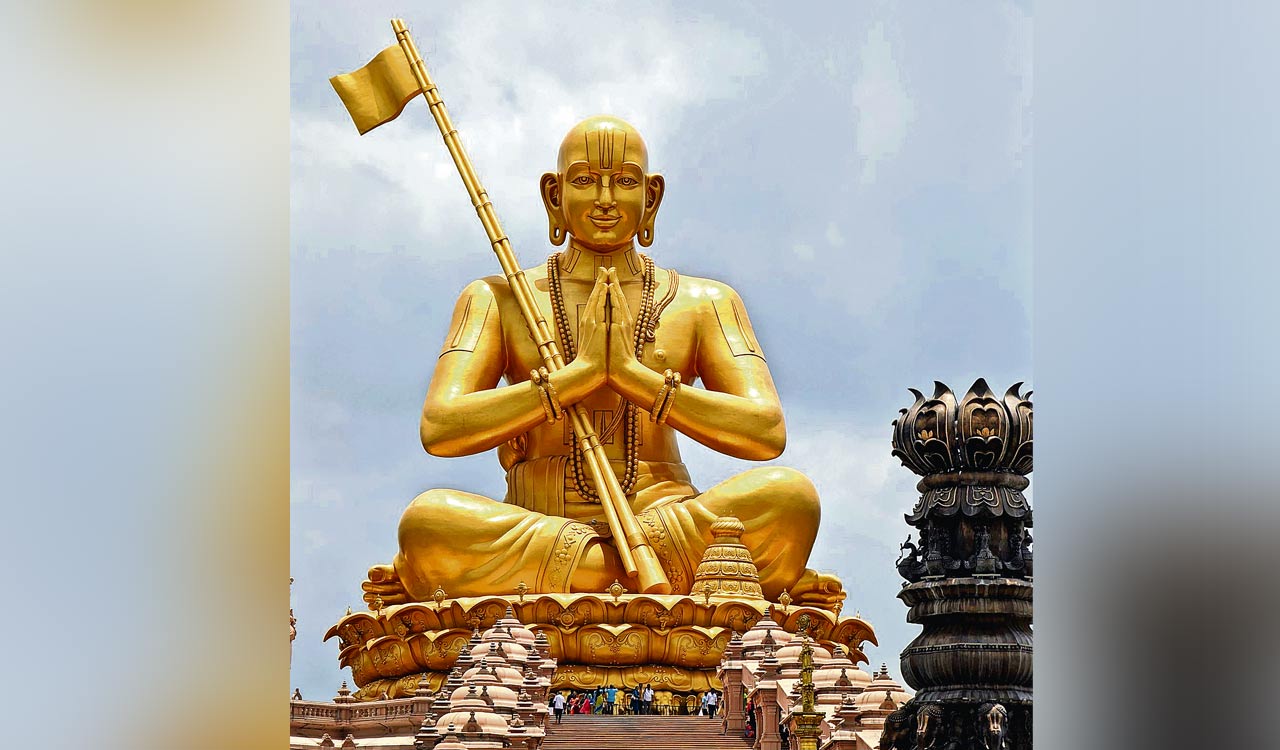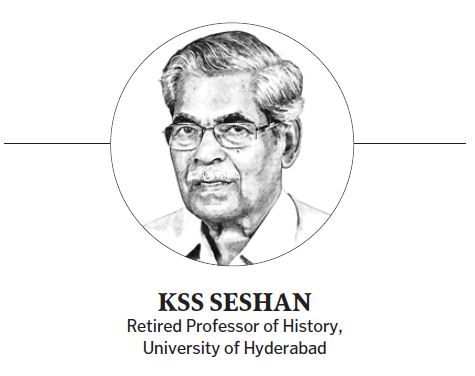Ramanujacharya is relevant even today when the rigidity of the caste system dictates the social order
Published Date – 11:45 PM, Wed – 13 December 23

By KSS Seshan
Muchintal, near Hyderabad, hogged the nationwide limelight during the unveiling of the Statue of Equality, ‘Samatha Murthi’, of the 11th century Saint Ramanujacharya by the Prime Minister on 5 February 2022. Considered one of the largest statues in the world, the statue of Ramanuja, in the sitting posture, is about 216 feet in height. Sri Tridandi Chinna Jeeyar Swamy was the brain behind this mammoth statue that cost more than Rs 1,000 crore. But then who was Ramanujacharya and what was his contribution so as to have such a huge memorial to commemorate him after nearly a thousand years of his physical existence?
Saint Ramanuja was a Hindu theologian, spiritual reformer and one of the most important exponents of Sri Vaishnava tradition in Hinduism. His philosophical foundations with due emphasis on devotion profoundly influenced the much-acclaimed Bhakti movement that swept the country during the later centuries. Therefore, the great relevance of Ramanuja lies not so much during his own lifetime but during the succeeding generations, when his teachings impacted several movements throughout the country.
Ramanujacharya’s chief contribution to philosophy was that the phenomenal world is real and provides true knowledge, and that the pursuit of daily life is not detrimental or contrary to the life of the spirit. In this emphasis, he differed from Adi Shankara whose interpretation of the scriptures, he disputed. Though Ramanuja’s contribution to the Vedanta thought was very significant, his influence on Hinduism as a religion was much greater. By making devotional worship (Bhakti) his doctrine, he gave it an intellectual basis. From then on, Bhakti became an integral part of the Hindu faith. This concept of Bhakti or devotionalism found its way to north India and highly influenced what later came to be known as the ‘Bhakti Movement’.
Like Adi Shankara, Ramanuja accepted the reality of matter, soul and God, the three distinct orders, and that there is non-duality (‘Advaita’), an ultimate identity of the three orders. But this non-duality, for Ramanuja, was an assertion of God who is modified or qualified non-duality, ie ‘Visishtadvaita’.
Early Life
Ramanuja was born in 1017 AD in a Brahmin family at Sriperumbudur near the present city, Chennai, in Tamil Nadu. He was trained in the Advaita Monastic tradition early in life. But being a rebel, Ramanuja soon disagreed with this non-dualistic ‘Advaita’ as propounded by Adi Shankara and instead followed the Tamil Alwars’ tradition. Ramanuja thus paved the way for a new line of thinking within Vaishnavism that was dissimilar to Shankara’s non-dualism as well as Madhvacharya’s ‘Dvaita’ philosophy (Theistic Dualism). Ramanuja’s philosophy came to be known as ‘Visishtadvaita Vaishnavism’. Together, these three proponents were the triumvirate of the Vaishnava sect. He also emphasised the importance of Bhakti or devotion to a personal God as a means to liberation.
Ramanuja, like most of the youth of his day, got married, and moved to Kanchipuram where he became a priest at the famous Varadaraja Perumal Temple for a living. It was here that he was initiated into ‘Srivaishnavism’ by one Priya Nambi, also called Mahapurana, a great Vaishnavite scholar of the time. Ramanuja renounced his married life and took to ‘sanyas’. He soon became a sensation as he disputed Adi Shankara’s theories and offered an alternative interpretation of Upanishadic scriptures. His fame grew with his fearless debates and discourses.
Reformative Theology
Ramanuja belonged to a society of pluralistic beliefs where Vaishnavism, Shaivism and Smartha traditions besides Buddhism and Jainism thrived together. However, it was the time when the ‘Advaita Vedanta’ had been dominant. Islam had not made any dent into South India by then. Ramanuja also spent a few years in Srirangam before he moved towards Karnataka where he lived for several years in the Hoysala kingdom. Legend has it that there he even converted the Jaina King Bitti Deva to ‘Srivaishnavism’ and with his patronage, built a temple at Melkote in the present Mandya district of Karnataka.
A significant contribution of Ramanuja to Hinduism was the social equality that he preached. At a time when the rigidity of the caste system dictated the social order, Ramanuja, following in the footsteps of the Alwars, revolted against caste discrimination in the Hindu faith. He called the socially marginalised castes ‘Thirukulathar’, meaning, ‘of noble descent’. Ramanuja broke all caste barriers and was instrumental in admitting those caste groups into the Melkote temple, and set an example to usher in a society where all castes were to be equal with no discrimination based on birth.
His liberal views also led to the reorganisation of rituals in the Srirangam temple and the involvement of non-Brahmins in conducting ‘Vaishnava’ worship and rituals. This policy change in temple worship, given the order of the then times of fundamentalism, contributed immensely to the enhancement of the social status of the artisanal classes, particularly the weavers. However, Ramanuja had to incur the wrath of the traditional priests and other fanatics who even attempted unsuccessfully to eliminate him.
Pan-India Outreach
Ramanuja undertook nationwide tours and like Adi Shankara visited all major temples or religious centres in the country. His visits, debates and discourses triggered conversions of not only Jains and Buddhists but even Shaivites and others to ‘Vaishnavism’. The temple traditions as propagated by Ramanuja are being followed even now in many important and prominent Vaishnava temples like the Ranganathaswamy Temple at Srirangam and the Venkateswara Temple at Tirupati. It was at Srirangam that he wrote the most influential ‘Visishtadvaita’ philosophy text, ‘Sri Bhashyam’, a commentary on Brahma Sutras. Ramanuja wrote a number of treatises and religious texts in Sanskrit. An exhaustive review and commentary on Bhagavad Gita by him is considered an authoritative treatise on the subject.
Ramanuja came to be regarded as the single most influential thinker of devotional Hinduism who vehemently opposed caste cleavages with a very egalitarian social outlook at a time when ‘Varnashrama’ dharma was the order of the day. It is precisely for this one reason that Ramanujacharya is relevant today when we are heading towards aspects like government-sponsored ‘caste census’ to perpetuate and nurture the highly despicable discrimination based on caste.





